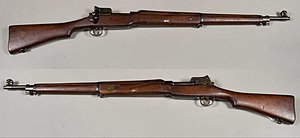Pattern 1914 rifle
| Pattern 1914 rifle | |
|---|---|

|
|
| general information | |
| Military designation: | Pattern 14 Rifle, later Rifle No 3 MK 1 and MK 1 * |
| Country of operation: | United Kingdom , various Commonwealth countries |
| Developer / Manufacturer: | Developer: Enfield Royal Small Arms Factory Manufacturer: Remington Arms , Eddystone Rifle Plant, Winchester Repeating Arms Company |
| Development year: | 1913 |
| Manufacturer country: | United States |
| Production time: | since 1914 |
| Model variants: | Pattern 13 Rifle, |
| Weapon Category: | gun |
| Furnishing | |
| Overall length: | 1175 mm |
| Weight: (unloaded) | 4.25 kg |
| Barrel length : | 660 mm |
| Technical specifications | |
| Caliber : | .303 British |
| Possible magazine fillings : | 5 cartridges |
| Number of trains : | 5 |
| Twist : | Left |
| Visor : | Hole notch and front sight |
| Closure : | Cylinder lock |
| Lists on the subject | |
The Pattern 1914 Rifle , (later Rifle No 3 MK 1, MK 1 * and MKII) is a bolt- action rifle with a Mauser barrel bolt system in .303 caliber developed by the Enfield Royal Small Arms Factory and used by the armed forces of the United Kingdom in both World Wars British .
history
The Pattern 13 Rifle in caliber .276 Enfield (similar to the Canadian .280 Ross cartridge) was developed by the Enfield Royal Small Arms Factory as the successor to the Short Magazine Lee-Enfield Rifle (SMLE Rifle) and produced in a pilot series of 1,250 for testing . Since the weapon did not prove itself and the barrels quickly wore out, the standard caliber of the British Army was selected for the series-produced rifle, designation of the weapon: Pattern 1914 Rifle (short: P14 Rifle). Vickers Limited was intended as the manufacturer .
During the First World War , the needs of the British armed forces for infantry rifles could not be met by local industry. Vickers Limited was engaged in the manufacture of the Vickers MGs . The series production of the P14 rifle was therefore started by the US company Remington Arms under the name Pattern 14 MK IR , at the Eddystone Rifle Plant in Chester (Pennsylvania) run by John T. Thompson and managed by John T. Thompson under Pattern 14 MK IE and at Winchester under Pattern 14 MK IW carried out. A total of 1,235,298 Pattern 14 MK I rifles were produced, with the Eddystone Rifle Plant producing most of the weapons. The M1917 rifles for the US troops were also manufactured there later .
technology
The cylinder lock is based on the Mauser system. It locks at the front in the barrel extension screwed on at the end of the barrel. The safety device is derived from the Spanish Mauser model 1892, the safety lever is located at the rear right on the locking sleeve. The magazine holds five rounds and is loaded with a loading frame . The sighting device is protected by a solid frame and mounted over the lock behind the ejection opening. The rear sight can be adjusted from 200 to 1200 yards shooting range. A vernier is used for fine adjustment . The lateral direction can be adjusted with a screw. The rifles with a mounting device for the English riflescope Model 18 have the additional designation No 3 MK I (T) . Because of their better quality, only weapons from Winchester production were used for this modification.
Because of its lock that locks in the barrel extension at the front, the one-piece construction of the barrel and piston, the longer line of sight with rear sight, the P14 rifle is superior to the SMLE rifle in stability and precision, the advantage is a slightly higher weight, 4.25 kg instead of 3 , 9 kg bought.
commitment
During the First World War, the P14 rifle was given to all armies of the Commonwealth in addition to the SMLE rifle and used in all theaters of war. Because of its precision thanks to its structure (longer line of sight) of the diopter sight, it was popular with snipers. Use of the P14 rifle until retirement:
- United Kingdom
- Various Commonwealth countries
- Israel Defense Forces (Tzva haHagana leJisra'el)
- Estonia with resistance troops from 1939
- India
- Luxembourg
- Philippines
- Greece
- Poland
After the First World War, the weapons were stored. Before the Second World War they were revised and then used by various combatants under their new designation Rifle No 3 MK 1 and MK 1 * .
In addition to arming foreign Commonwealth troops, they were used to arm rear services of the British Army, and they were also given to the British Home Guard . Because of their precise shooting performance, they were equipped with a telescopic sight for snipers, as in the First World War. The Australian Army deployed a large number of these telescopic P14 rifles during World War II.
In 1947 they were retired from the armies of the Commonwealth of Nations.
Various of these weapons have been sold to large-caliber shooting clubs in the Commonwealth, Australia, Canada, New Zealand and South Africa.
literature
- Charles R. Stratton: British Enfield Rifles, Volume 4, The Pattern 1914 and US Model of 1917 Rifles. North Cape Publications, 2000, ISBN 1-882391-29-2 .
- WHB Smith, Joseph E. Smith, The Book of Rifles 1963, Stackpole Co, Harrisburg, PA
- WHB Smith, Joseph E. Smith, Small Arms of the World 1962, Stackpole Co, Harrisburg, PA
- Department of the Army ROTC Manual, American Military History 1607-1953 , Dept of the Army, Washington DC


